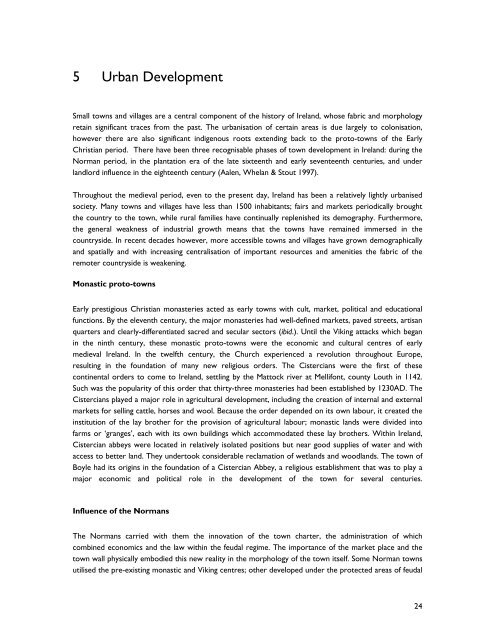archaeological & built heritage assessment - The Heritage Council
archaeological & built heritage assessment - The Heritage Council
archaeological & built heritage assessment - The Heritage Council
Create successful ePaper yourself
Turn your PDF publications into a flip-book with our unique Google optimized e-Paper software.
5 Urban Development<br />
Small towns and villages are a central component of the history of Ireland, whose fabric and morphology<br />
retain significant traces from the past. <strong>The</strong> urbanisation of certain areas is due largely to colonisation,<br />
however there are also significant indigenous roots extending back to the proto-towns of the Early<br />
Christian period. <strong>The</strong>re have been three recognisable phases of town development in Ireland: during the<br />
Norman period, in the plantation era of the late sixteenth and early seventeenth centuries, and under<br />
landlord influence in the eighteenth century (Aalen, Whelan & Stout 1997).<br />
Throughout the medieval period, even to the present day, Ireland has been a relatively lightly urbanised<br />
society. Many towns and villages have less than 1500 inhabitants; fairs and markets periodically brought<br />
the country to the town, while rural families have continually replenished its demography. Furthermore,<br />
the general weakness of industrial growth means that the towns have remained immersed in the<br />
countryside. In recent decades however, more accessible towns and villages have grown demographically<br />
and spatially and with increasing centralisation of important resources and amenities the fabric of the<br />
remoter countryside is weakening.<br />
Monastic proto-towns<br />
Early prestigious Christian monasteries acted as early towns with cult, market, political and educational<br />
functions. By the eleventh century, the major monasteries had well-defined markets, paved streets, artisan<br />
quarters and clearly-differentiated sacred and secular sectors (ibid.). Until the Viking attacks which began<br />
in the ninth century, these monastic proto-towns were the economic and cultural centres of early<br />
medieval Ireland. In the twelfth century, the Church experienced a revolution throughout Europe,<br />
resulting in the foundation of many new religious orders. <strong>The</strong> Cistercians were the first of these<br />
continental orders to come to Ireland, settling by the Mattock river at Mellifont, county Louth in 1142.<br />
Such was the popularity of this order that thirty-three monasteries had been established by 1230AD. <strong>The</strong><br />
Cistercians played a major role in agricultural development, including the creation of internal and external<br />
markets for selling cattle, horses and wool. Because the order depended on its own labour, it created the<br />
institution of the lay brother for the provision of agricultural labour; monastic lands were divided into<br />
farms or ‘granges’, each with its own buildings which accommodated these lay brothers. Within Ireland,<br />
Cistercian abbeys were located in relatively isolated positions but near good supplies of water and with<br />
access to better land. <strong>The</strong>y undertook considerable reclamation of wetlands and woodlands. <strong>The</strong> town of<br />
Boyle had its origins in the foundation of a Cistercian Abbey, a religious establishment that was to play a<br />
major economic and political role in the development of the town for several centuries.<br />
Influence of the Normans<br />
<strong>The</strong> Normans carried with them the innovation of the town charter, the administration of which<br />
combined economics and the law within the feudal regime. <strong>The</strong> importance of the market place and the<br />
town wall physically embodied this new reality in the morphology of the town itself. Some Norman towns<br />
utilised the pre-existing monastic and Viking centres; other developed under the protected areas of feudal<br />
24
















